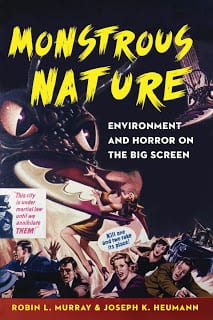Monstrous Nature: Environment and Horror on the Big Screen
Godzilla, a traditional natural monster and representation of cinema’s subgenre of natural attack, also provides a cautionary symbol of the dangerous consequences of mistreating the natural world—monstrous nature on the attack. Horror films such as Godzilla invite an exploration of the complexities of a monstrous nature that humanity both creates and embodies.
Robin L. Murray and Joseph K. Heumann demonstrate in Monstrous Nature how the horror film and its offshoots can often be understood in relation to a monstrous nature that has evolved either deliberately or by accident and that generates fear in humanity as both character and audience. This connection between fear and the natural world opens up possibilities for ecocritical readings often missing from research on monstrous nature, the environment, and the horror film.
Organized in relation to four recurring environmental themes in films that construct nature as a monster—anthropomorphism, human ecology, evolution, and gendered landscapes—the authors apply ecocritical perspectives to reveal the multiple ways nature is constructed as monstrous or in which the natural world itself constructs monsters. This interdisciplinary approach to film studies fuses cultural, theological, and scientific critiques to explore when and why nature becomes monstrous.
Robin L. Murray is a professor of English at Eastern Illinois University. Joseph K. Heumann is professor emeritus from the Department of Communication Studies at Eastern Illinois University. Murray and Heumann are coauthors of That’s All Folks?: Ecocritical Readings of American Animated Features (Nebraska, 2011) and Film and Everyday Eco-disasters (Nebraska, 2014)

